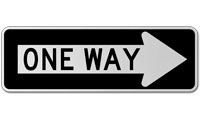
There are several hundred federally approved road signs in use today. With that many signs it can be a little overwhelming to try and learn each individual message. Thankfully, you can understand the meaning of a road sign by simply learning about what colors, shapes, and symbols are used.
In order to help drivers process road sign meanings faster, the U.S. Department of Transportation (DOT) moved towards the use of symbols rather than words. Symbols are far better at conveying different safety messages, they are easier to recognize and understand, and they are fairly universal. The use of symbols is quickly becoming the standard for traffic control devices throughout the world.
The DOT also has a standard for the color and shape of particular signs. These colors and shapes are essential to understanding the meaning of road signs. They are also becoming universal. For example, if you see a red and white octagonal sign it’s safe to assume that sign means stop. This goes for most signs that follow the standards.
The color codes below are from the 2009 Manual on Uniform Traffic Control Devices (MUTCD) for Streets and Highways. They are the most up-to-date revisions for the color code system currently available.
The color of road signs are an important indicator of the information they present. By learning the color of the sign, you can start to understand what to expect from that sign. Think about how many times you’ve come across a yellow sign and instantly knew that it was warning you of something. That is one of the benefits you gain from learning corresponding colors.
If road sign colors provide consistency across our infrastructure, then road sign shapes further establishes this consistency. Each shape connotes a specific meaning too. When combined, the shape and color of a road sign can often alert drivers to the meaning of the sign prior to reading the contents. In some instances, the ability to make out the shape and color of a sign is more important than being able to read the sign.
Now that you know what each color and shape means, let’s take a look at five specific signs. We provided the meaning for each sign so that you have a better idea of how to use colors and shapes in combination.

1. One Way Sign – this sign is used to indicate streets or roadways where traffic is allowed to travel in one direction only. It features a white and black color scheme, indicating that it’s a traffic regulation. One Way Signs are rectangular to provide guidance to the driver and further solidify its regulatory theme.
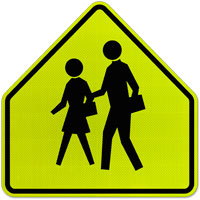
2. School Zone Sign – this sign is used to identify the location of a designated school zone, warn drivers that they’re approaching a school area, or warn drivers that they are approaching a school zone crossing. The fluorescent yellow-green color scheme in this instance indicates that there are pedestrians present as well as a school zone. The pentagon does similar by indicating there is a school zone ahead or a school crossing zone.
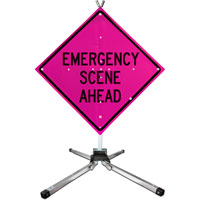
3. Emergency Scene Ahead Sign – this sign is used to warn drivers that there is some form of motor vehicle accident or emergency ahead and they should proceed with caution. The fluorescent pink indicates that there is an incident nearby. The diamond shape, meanwhile, warns of possible hazards ahead.
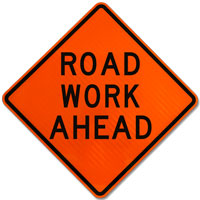
4. Road Work Ahead Sign – this temporary warning sign serves as a general warning of obstructions or restrictions. It’s located in advance of road construction. The orange is used to indicate that traffic is being temporarily affected and the diamond shape warns of possible hazards. When you see a construction sign like this one, it’s best to slow down, proceed with caution, and monitor other signs that may be present.
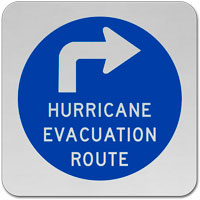
5. Hurricane Evacuation Route Sign – this sign is used to help drivers navigate through the nearest hurricane evacuation route. The blue color further indicates the nature of the sign, while the rectangle helps to provide guidance to drivers. Hurricane Evacuation Route Signs may also be accompanied by another blue and white sign telling you to tune into a specific radio station for further instructions.
SafetySign.com does not recommend or specify the use of a specific safety sign because it does not have knowledge of the hazard(s) our customers are identifying. It is the customer’s sole responsibility to identify the hazard(s) that may be present and select one or more signs (stock or custom) that accurately identify their specific hazard(s) and complies with any applicable federal, state or local laws or regulations, any worksite specific rules or regulations and/or any applicable safety standards (including, without limitation, MUTCD standards). SafetySign.com disclaims any and all liability (excluding liability for our Product Warranty contained in our Terms and Conditions) for any sign selected by a customer and shall not be responsible for any personal injury or property damage resulting from the use of signs purchased from it or for the independent interpretation made of any applicable federal, state or local laws or regulations, any worksite specific rules or regulations, and/or any applicable safety standards (including, without limitation, MUTCD standards). Customer shall indemnify and hold SafetySign.com and its corporate parent and its officers, directors and affiliates harmless from and against any and all claims, loss or expense (including attorneys’ fees) arising from or related to the purchase and use by customer or any third party of any sign purchased by customer from SafetySign.com.